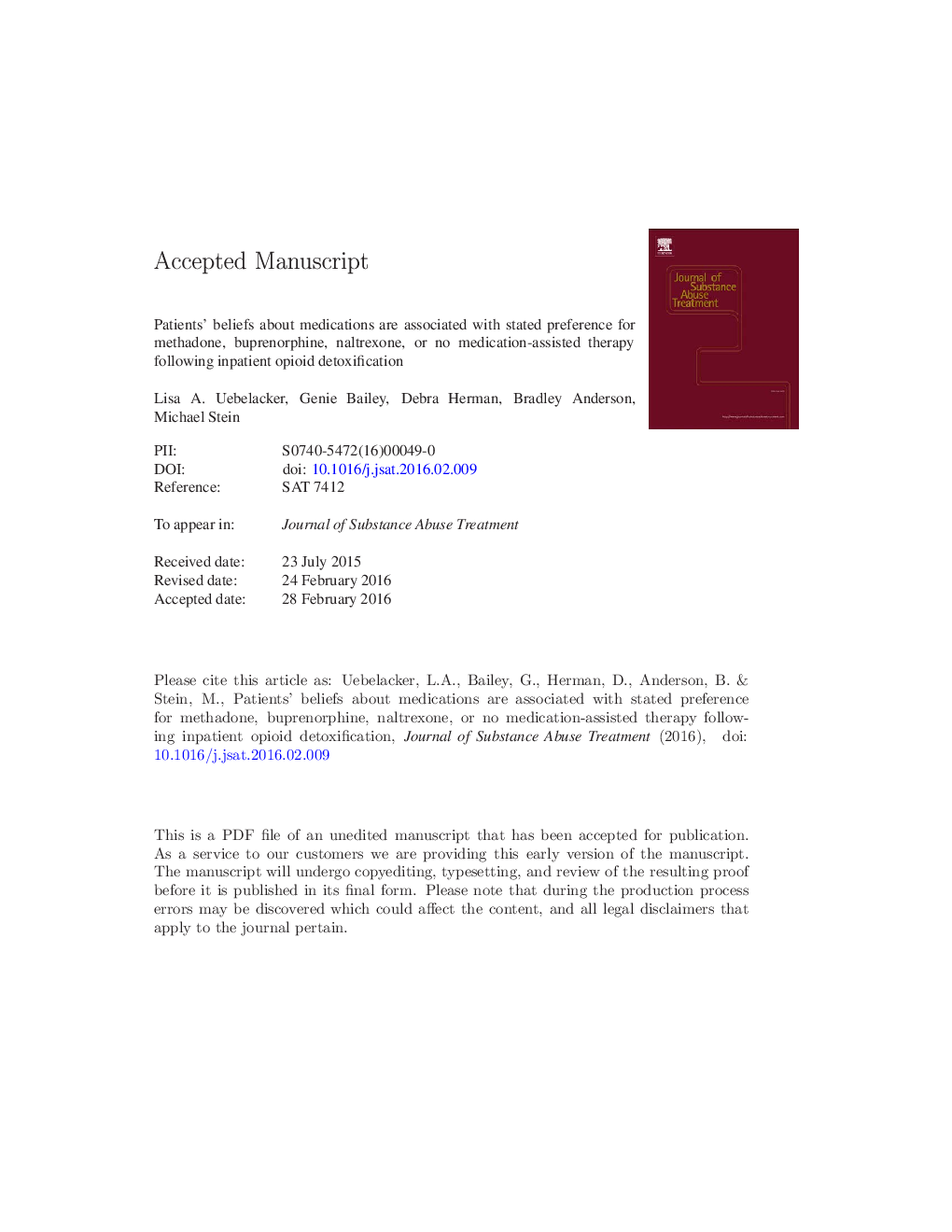| کد مقاله | کد نشریه | سال انتشار | مقاله انگلیسی | نسخه تمام متن |
|---|---|---|---|---|
| 6802337 | 543559 | 2016 | 27 صفحه PDF | دانلود رایگان |
عنوان انگلیسی مقاله ISI
Patients' Beliefs About Medications are Associated with Stated Preference for Methadone, Buprenorphine, Naltrexone, or no Medication-Assisted Therapy Following Inpatient Opioid Detoxification
ترجمه فارسی عنوان
اعتقادات بیماران درباره داروها با توجه به میل متادون برای متادون، بوپرنورفین، نالترکسون و یا بدون درمان دارویی پس از اتمام درمان اپیدمی
دانلود مقاله + سفارش ترجمه
دانلود مقاله ISI انگلیسی
رایگان برای ایرانیان
کلمات کلیدی
اپیوئیدها، اولویت ها، متادون، بوپرنورفین، نالترکسون،
موضوعات مرتبط
علوم زیستی و بیوفناوری
علم عصب شناسی
روانپزشکی بیولوژیکی
چکیده انگلیسی
Subsequent to initial opioid detoxification, people with opioid use disorder are typically advised to engage in follow-up treatment to prevent relapse. Medication-assisted treatments (MATs) - i.e., the opioid agonist methadone (MMT) or partial agonist/antagonist, buprenorphine/naltrexone (BUP) -- are the maintenance treatment options with the best research support for positive outcomes. A third MAT, injectable extended-release naltrexone (XR-NTX), was approved by the FDA for opioid dependence in 2010 and shows promise. However, relatively few eligible patients choose to initiate one of these MATs following initial detoxification treatment. Consistent with the health belief model, we hypothesized that beliefs about 1) efficacy of each MAT; 2) safety of each MAT; and 3) perceived consistency with being drug-free would predict stated patient preferences for a particular MAT or for no MAT. We also hypothesized that perceived structural barriers (e.g., time, transportation) would decrease the likelihood of stating a preference for a given MAT. To assess these hypotheses, we surveyed 372 people undergoing inpatient opioid detoxification treatment. Results supported hypotheses for all 3 sets of patient beliefs, with the patient group stating that they preferred a particular MAT having significantly more positive beliefs about that MAT relative to other groups (p < .001). The group that preferred “no MAT” had the most negative beliefs about all MATs. Perceived structural barriers were not related to stated preferences, except that people who preferred BUP were more likely to endorse barriers to MMT than any of the other 3 groups. Notably, a relatively high proportion (32%) of participants were most interested in XR-NTX despite a lack of prior experience with this medication. These results suggest that efforts to increase MAT enrollment following detoxification might benefit from including patient beliefs as one set of factors to assess and target for change.
ناشر
Database: Elsevier - ScienceDirect (ساینس دایرکت)
Journal: Journal of Substance Abuse Treatment - Volume 66, July 2016, Pages 48-53
Journal: Journal of Substance Abuse Treatment - Volume 66, July 2016, Pages 48-53
نویسندگان
Lisa A. Ph.D., Genie M.D., Debra Ph.D., Bradley Ph.D., Michael M.D.,
